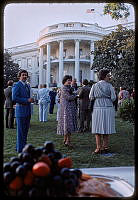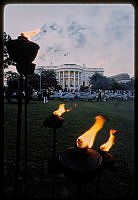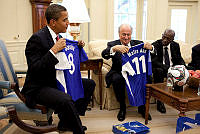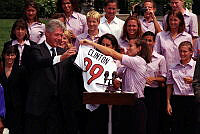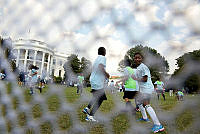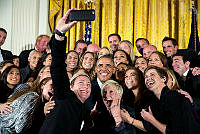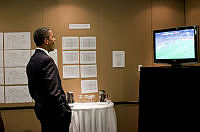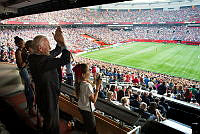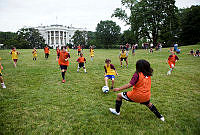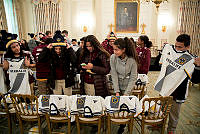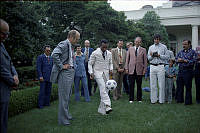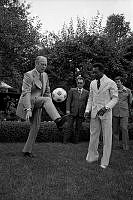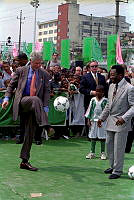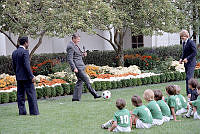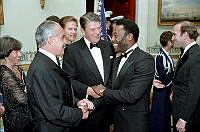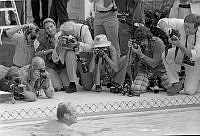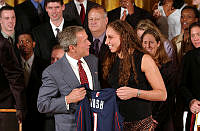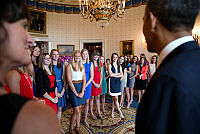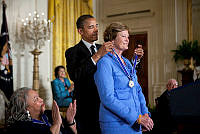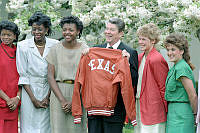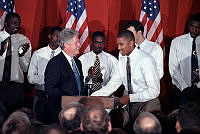Rubenstein Center Scholarship
Dan Jansen
A Winter Olympics Story of Perseverance
Speed skater Dan Jansen’s gold medal victory is one of the most inspiring Olympic stories in American history. The four-time Olympian and seven-time World Cup champion won a gold medal in his final Olympic race in the 1994 Winter Games in Lillehammer, Norway. Jansen’s road to the gold was riddled with disappointments, family illness, and personal challenges, yet he persevered to win Olympic gold.
Dan Jansen was born on June 17, 1965, in a suburb of Milwaukee, Wisconsin. He was the youngest of nine children and the son of a police officer and nurse. Dan’s sister Jane introduced him to the sport of speed skating, and he began winning competitions at an early age.1
In 1984, he competed in his first Olympics in Sarajevo, Yugoslavia. He did surprisingly well, placing fourth in the 500-meter race. Speed skating insiders viewed Jansen as a rising talent in the sport and a likely future gold medal contender.
In 1987, his sister Jane was diagnosed with leukemia. Jansen considered stopping his training to help with his sister’s medical care, but she encouraged him to continue. In 1988, Jansen headed to the Winter Olympics in Calgary, Canada, as the favorite in both the 500-meter and 1000-meter races. On February 14, 1988, Dan Jansen learned that Jane had died. His family encouraged Jansen to skate the 500-meter race later that day. Jansen false-started and then fell during the first turn, colliding with a Japanese skater. He subsequently competed in the 1000-meter race, but he fell again. The outpouring of support for Jansen across the United States was substantial. He received thousands of letters of sympathy and encouragement.2

President Ronald Reagan meets with the Winter Olympics speed skating team, including Dan Jansen, in the East Room on March 8, 1988.
Ronald Reagan Presidential Library and Musem/NARAOn February 28, 1988, Dan Jansen received the U.S. Olympic Committee’s Spirit Award, which recognized his “valiant efforts through tragedy.”3 On March 8, 1988, President Ronald Reagan invited Dan Jansen to visit the White House, along with other United States Olympic athletes. President Reagan met with members of the Olympic team in the East Room and posed for photographs. At the subsequent ceremony in the Rose Garden, President Reagan spoke about Jansen’s courage:
"Talking about gold medals from America's heart, there's one that goes to Dan Jansen for his courage, and one that goes to his family, too. Their devotion to each other captured the heart and earned the admiration of our entire land. Dan, you received the United States Olympic Committee's Olympic Spirit Award and everyone here and around the country applauds the committee's choice. You dedicated that honor to your sister, her memory, and your entire family. And now you're back in competition and number one in World Cup points. Yes, your family is very precious in your life, and if recently a cause of great sadness, it is also a source of great strength. And that strength is an inspiration to the entire world."4
As President Reagan mentioned in his speech, Jansen returned to international competition almost immediately after the Calgary Olympics.
In the 1992 Winter Olympics in Albertville, France, Dan Jansen finished fourth in the 500-meter race and a disappointing twenty-sixth in the 1000-meter race. However, Jansen had one more opportunity to medal in the Olympics. The International Olympic Committee decided to stagger the winter and summer games so that Olympic competition would take place every two years rather than every four. That meant the next Winter Olympics would take place in 1994 in Lillehammer, Norway.
In Norway, Jansen started fast in the 500-meter race, but slipped on the final turn. He finished eighth overall.5 That meant that Jansen only had one more Olympic competition left in Lillehammer, the 1000-meter race. Although Jansen had a minor slip on a turn, he recovered and won the Olympic gold medal and set a new world record. When he took his victory lap around the ice, his eight-month-old daughter Jane, named after his sister, joined him.

U.S. Olympic gold medal winner Dan Jansen speaks with Hillary Clinton at a local Washington, D.C. area school before visiting the White House on April 13, 1994.
Denis Paquin/AP/ShutterstockJansen later learned that President Bill Clinton wanted to speak with him while participating in a post-race press conference. President Clinton, who placed the call from his study in the White House, congratulated Jansen personally on his victory, representing an entire nation who had watched Jansen suffer through personal tragedy, loss, and defeat. Jansen described the call to the press: “He said, the whole country’s proud. He said he was expressing how the whole country was pulling for me.” First Lady Hillary Rodham Clinton also telephoned Jansen a few minutes later to express her congratulations.6 The United States Olympic Team chose Jansen to carry the American flag at the closing ceremonies in Lillehammer.
On April 13, 1994, members of the United States Winter Olympic team joined the president, first lady, and Vice President Al Gore in the East Room of the White House for a ceremony. Jansen, along with other medal winners, attended the event. During his remarks, President Clinton commented that he enjoyed the Olympics “primarily as a citizen.” He confessed that he stayed up every night “until you went off the air” and consequently, he might have jokingly “endangered the national security.”7 At the ceremony, each athlete had their picture taken with the president, first lady, and vice president at the White House and then attended a black-tie dinner honoring the team at the Washington Hilton.8
For his remarkable perseverance and inspirational story, Dan Jansen received the 1994 James E. Sullivan Award, which is awarded to the most outstanding amateur athlete in the United States. Later that year, Jansen retired from competitive speed skating. He is an Olympic speed skating commentator and founder of the Dan Jansen Foundation, which helps families affected by leukemia and related cancers.













